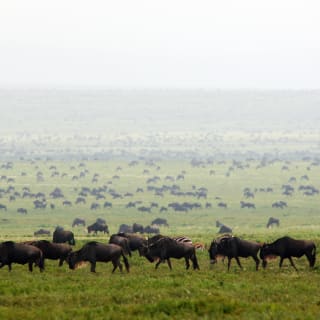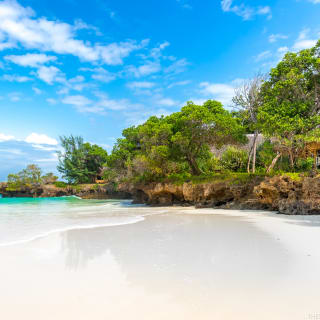
Packing List for an African Safari
Essential Items You Can't Miss
Essential Items You Can't Miss
Embarking on a safari in Africa is a thrilling adventure that requires thorough preparation for an optimal experience. Here’s a guide to ensure you're well-equipped for your journey.
The Right Clothing for an African Safari
Choosing the right clothing is crucial for adapting to the climatic conditions and activities during your safari. It’s not just about comfort and protection from the elements but also about enhancing your wilderness encounters.
Basic Clothing Items
Certain clothing items are essential for any safari, providing both protection and practicality:
- Long-Sleeved Shirts and Long Pants: These protect your skin from the sun, insect bites, and scratches from thorns or brush. Despite the heat in many parts of Africa, these items are essential for staying warm during early morning and evening drives in open vehicles.
- Neutral and Earthy Tones: Colors like khaki, brown, and gray help you blend into the environment and avoid attracting attention from animals. Avoid bright colors and military-style camouflage, which can be inappropriate in some regions.
- Closed Shoes: Crucial for walking safaris, they protect against rough terrain, thorns, and ground-dwelling creatures. Well-broken-in hiking boots are recommended.
- Wide-Brimmed Hat: A hat provides essential protection against sunburn and heatstroke. A wide brim offers extra coverage for your face and neck.
- Avoid Strong Fragrances: To prevent deterring animals or bothering fellow travelers, avoid strong perfumes or aftershaves. However, using deodorant is advisable to minimize body odor.
Clothing for Different Weather Conditions
Depending on the season and region, the weather on a safari can vary greatly:
- Protection from Cold: Early morning and late evening drives can be unexpectedly chilly. A warm fleece jacket, long pants, and closed shoes are recommended. A blanket can be useful for nighttime safaris.
- Protection from Heat and Sunburn: In hot regions, it's important to cover your skin with loose-fitting, long-sleeved tops. A wide-brimmed hat offers additional protection. Sunscreen is essential even on cloudy days, as UV rays can penetrate clouds.
- Rain Protection: Even on hot, cloudless days, a waterproof jacket is a good safeguard against sudden weather changes.
These clothing items and gear significantly contribute to making your African safari safe and enjoyable.
Special Equipment for an African Safari
To ensure a memorable and safe safari experience, the right equipment is crucial. Beyond standard clothing, certain gear can enhance comfort and protect against the various challenges of the African wilderness.
Essential Gear for Safari Participants
Certain items should be on every safari packing list to prepare for all eventualities:
- Insect Repellent and Mosquito Nets: These are vital for protecting against insect bites, especially in malaria-prone areas.
- Sunscreen and After-Sun Lotion: Given the intense sun exposure in many parts of Africa, high-quality sun protection is indispensable.
- Polarized Sunglasses: These protect your eyes from UV rays and improve visibility in bright sunlight.
- Travel First Aid Kit: Include medications for common travel ailments like diarrhea, pain, and allergies, as well as any personal medications.
Our safaris offer a high level of comfort and safety. We use only selected accommodations where you don’t have to worry about clean drinking water and hygiene.
However, if you’re planning and booking your safari independently, consider including a water filter bottle, disinfectants, and wet wipes in your packing list. These ensure safe drinking water where tap water quality is uncertain and help maintain hygiene when washing facilities are limited.
Additional Equipment
For those seeking a more immersive experience or traveling under specific conditions, additional gear can enhance your safari:
- Binoculars and Camera Gear: A good pair of binoculars is essential for observing animals from a safe distance. A high-quality camera with extra memory cards and a lens cleaning kit will help capture unforgettable moments.
- Flashlight or Headlamp: These are especially useful for night safaris or in the camp after sunset.
- Daypack: A daypack is convenient for carrying all necessary items during day trips.
Our safaris provide a high level of comfort and are well-equipped. In our selected accommodations, you won’t need a sleeping bag, travel pillow, or lightweight travel blanket. However, if you are planning an independent safari with camping, these items can provide additional comfort and protection against the cold.
Preparing for Weather Conditions in Africa
Africa is a continent with a wide variety of climates, ranging from dry deserts to humid rainforests. This diversity necessitates careful planning and equipment selection for a safari.
Overview of Climate Zones and Weather Conditions
- Desert Climate (e.g., Sahara and Kalahari): Characterized by extreme temperature fluctuations between day and night and very low rainfall. Days can be extremely hot, while nights are often surprisingly cool.
- Savanna Climate: Found in large parts of East and Southern Africa, characterized by distinct dry and rainy seasons. During the dry season, temperatures are high and vegetation sparse, while the rainy season brings frequent heavy downpours.
- Tropical Rainforest Climate: Predominant in Central Africa, marked by high temperatures and humidity year-round, with frequent and intense rainfall.
Tips for Preparation
To prepare optimally for the varying weather conditions during a safari, travelers should take the following measures:
- Layered Clothing: Flexibility is key, so it's advisable to wear clothing in layers that can be adjusted according to the time of day and weather. Lightweight, breathable clothing for the day and warmer layers for cool evenings and nights are recommended.
- Rain Protection: In regions with high rainfall, waterproof clothing is essential. A reliable raincoat or poncho should not be missing.
- Sun Protection: High-quality sunglasses, a sun hat, and sunscreen with a high SPF are essential in all African climates to protect against strong UV radiation.
- Sufficient Hydration: In hot and dry areas, it's important to always have enough water on hand. A water bottle with a filter can be very useful in areas where water quality is uncertain.
- Adaptation to the Environment: In humid areas, it's advisable to wear quick-drying clothing that keeps the body cool. In colder regions, such as higher altitudes or at night, warmer clothing is appropriate.
By considering these aspects, every safari participant can better prepare for the diverse weather conditions in Africa, thereby optimizing their wilderness experience.
Experience the magic of Africa with experts who have explored every corner themselves
Your dream holiday, tailor-made by experts.
Our travel consultants not only admire Africa from afar, but explore the most impressive regions every year to experience the cultures, landscapes and safari experiences first-hand.
From the initial inspiration to the moment you return home full of stories, we will accompany you personally - be it by phone, email or WhatsApp, whenever you need us. Explore the wilderness of Africa, be enchanted by its breathtaking beauty and create unforgettable memories. Together we will create your unique safari adventure!
Experts for your Africa trip








